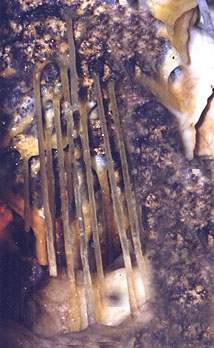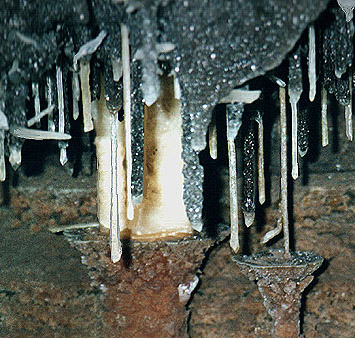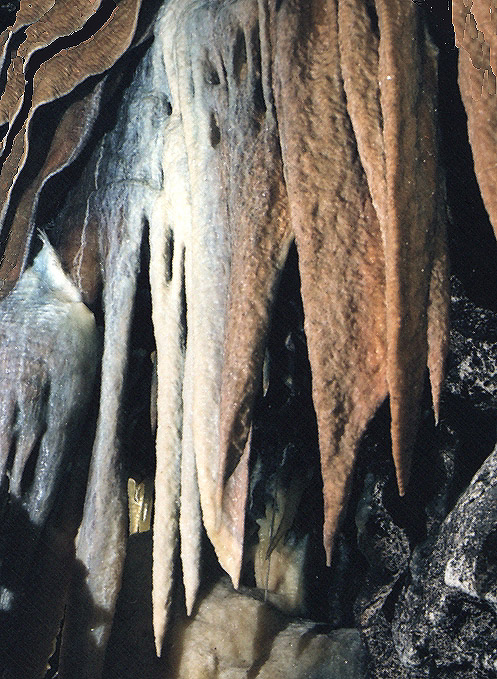GENERAL
How to be a Good Guest
Where is Bat Cave?
The AREA
Area rock Layers
Topography
Geomorphology
Geological History
The Paleozoic
The Mesozoic
The Cenozoic
Water
The Hydrologic Cycle
Solution
Solution chemistry
Karst Landscapes
Erosional Features
Depositional Features
Environmental Issues
BAT CAVE
How was Bat Cave formed?
Surface Plan of the site
Map of the Cave
Life in and around Bat Cave
A Virtual Trip Through Bat Cave
TEST YOUR KNOWLEDGE
 Depositional
Features:
Depositional
Features:
In the open air of the cave, some of the water may evaporate from the carbonate rich solution and increases the concentration of dissolved bicarbonate. Eventually, it becomes saturated and carbonate begins to precipitate. Alternately, the CO2 dissolved in water can come out of solution increasing the pH of water. Either or both of these processes cause previously disolved carbonates to precipitate on surfaces and to build up limestone deposits. The material deposited by ground water is called travertine or more informally, dripstone. Cave features or formations that are formed from dripstone accumulations are called speleothems thatmay grow as much as 1 cm/year under favorable conditions. They are as varied and unique in their expression as caves are. Some of the more common speleothems are:
 stalagmites,
generally blunter than stalactites and rising from the floor;
stalagmites,
generally blunter than stalactites and rising from the floor;
 soda
straws, thin, hollow stalactites from which probably all stalactites form
originally;
soda
straws, thin, hollow stalactites from which probably all stalactites form
originally;
 helictites
where the water passes through the center by capillary action rather than
gravity flow. Consequently helictites look like twigs and can grow in any
direction.
helictites
where the water passes through the center by capillary action rather than
gravity flow. Consequently helictites look like twigs and can grow in any
direction.
cave popcorn forms from travertine precipitating as water moves to the surface of a speleothem and evaporates from small openings.
 drip
curtains or draperies form as water comes through a crack or joint and
forms a linear curtain of stalactites;
drip
curtains or draperies form as water comes through a crack or joint and
forms a linear curtain of stalactites;
 Along
the edges of pools, rimstone will form as water evaporates; it may also
form along the edges of stalagmites within the pool and create pedestals.
Along
the edges of pools, rimstone will form as water evaporates; it may also
form along the edges of stalagmites within the pool and create pedestals.
If the water in the pools is constantly agitated, as from drips, cave pearls begin to form as carbonates precipitate on limestone particles in the pool, which act as seed grains. The constant motion of the water in the pool prevents the "pearl" from attaching to the sides of the pool but not from growing as additional travertine layers are added to its surface by precipitation.